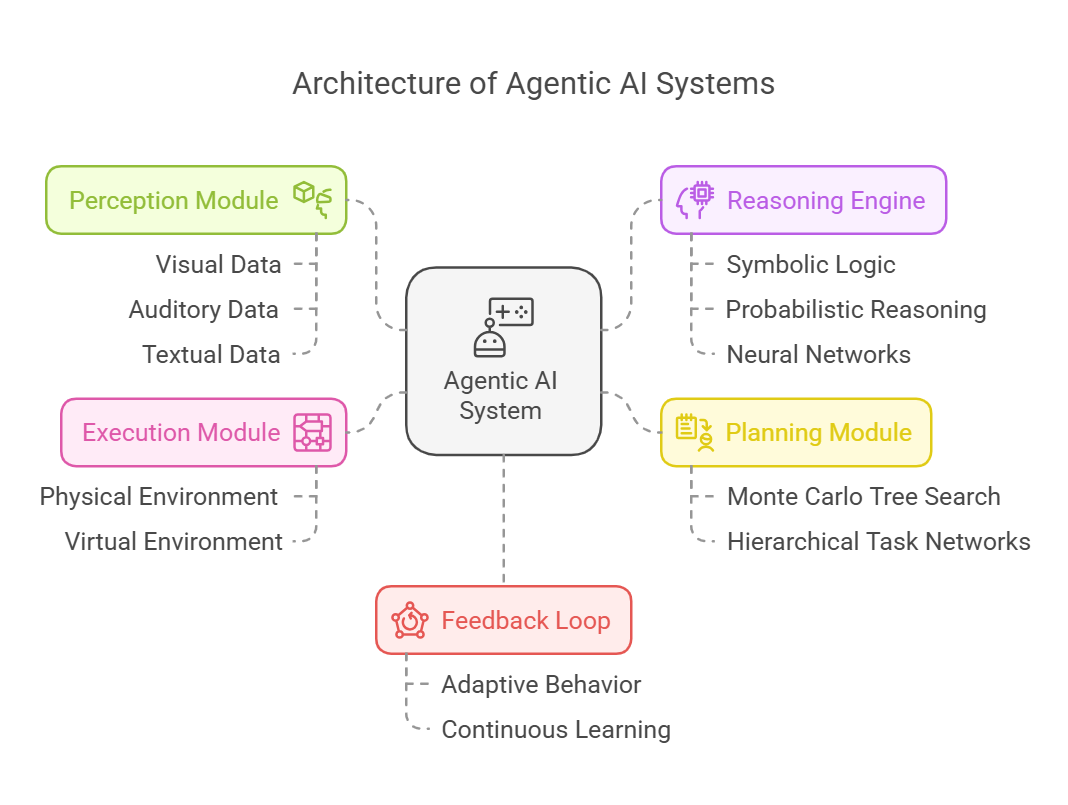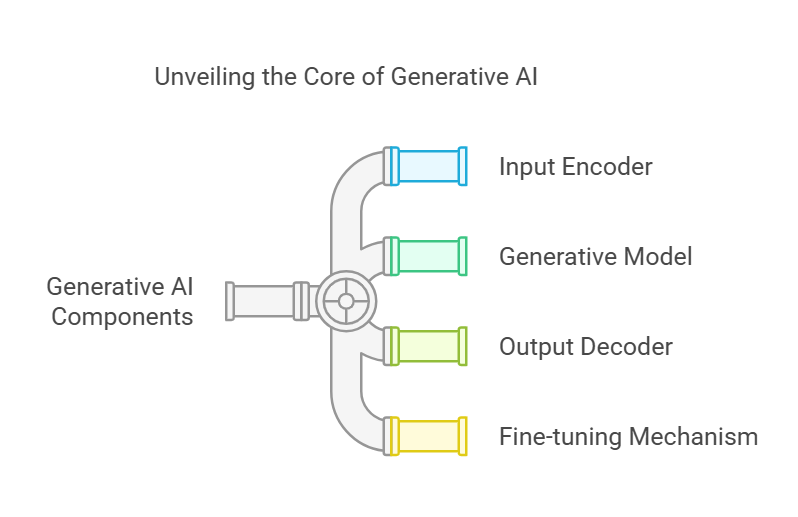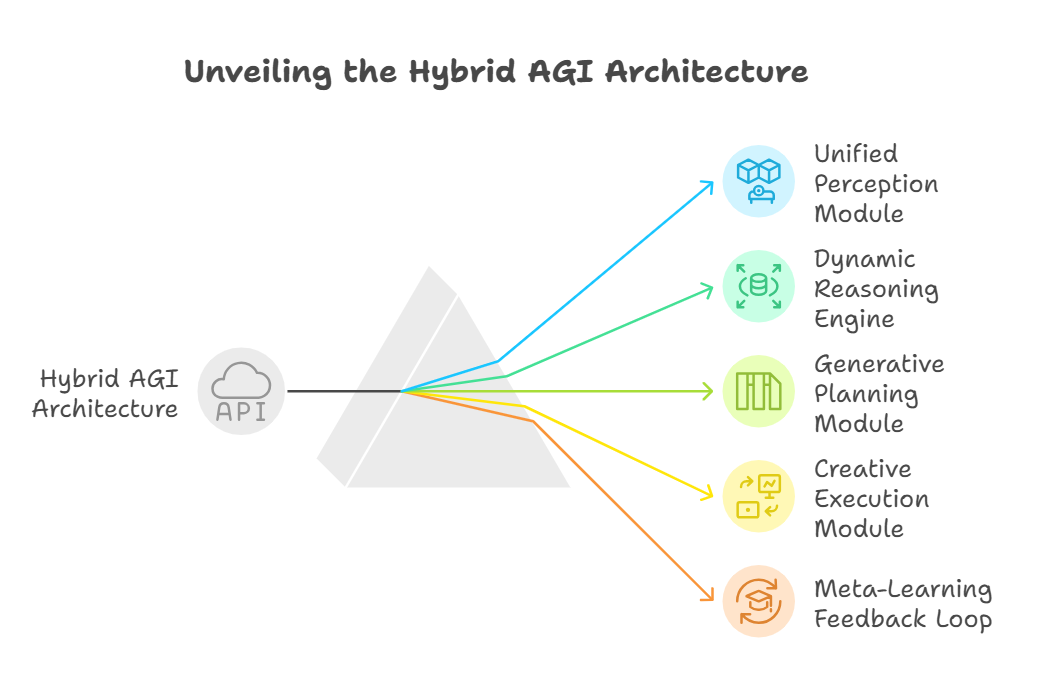Ijraset Journal For Research in Applied Science and Engineering Technology
- Home / Ijraset
- On This Page
- Abstract
- Introduction
- Conclusion
- References
- Copyright
A Step Forward to AGI: Integrating Agentic AI and Generative AI for Human-Like Intelligence
Authors: Akash Sakhare , Pruthviraj Chavan, Zaid Nandaniwala, Akanksha Patne , Mrunalinee Desai
DOI Link: https://doi.org/10.22214/ijraset.2025.66831
Certificate: View Certificate
Abstract
Artificial general intelligence (AGI) is the ultimate goal of artificial intelligence, which should be able to mimic human-like cognitive abilities in a variety of tasks. The developing junction of generative AI—creative, content-generating systems—and agentic AI—autonomous, goal-directed systems—is one of the possible routes to AGI. We discuss a comparative study of these two paradigms, focusing on their different approaches, underlying difficulties, and potential synergies. This research proposes a new angle in the light of AGI future, regarding how the autonomy and problem-solving abilities of Agentic AI are going to create the ingenuity and adaptability of Generative AI. Second, we have drawn attention toward other significant features that are supposed to characterize next-generation intelligent systems, including interdisciplinary research and its ethical implications. To ensure the responsible development of AGI technologies, the paper\'s conclusion provides a direction for advancing AGI, emphasizing the importance of cooperation between AI researchers, ethicists, and industry practitioners.
Introduction
I. INTRODUCTION
The aim of developing computers that would be cognitively as versatile as human beings, which is called artificial general intelligence, has been one of the strong cornerstones of AI research. In contrast to narrow AI, which is good at specific tasks, AGI would be adaptable, inventive, and versatile, similar to human intelligence, in various fields. Interest in AGI has renewed itself with the two newest pillars: generative AI, producing imaginative, human-like content, and agentic AI, which is autonomous. Although these domains have always evolved in tandem, the convergence of their advances is a revolutionary path to general intelligence. While generative AI brings the ability to imagine, create, and synthesize knowledge, agentic AI provides the foundation for autonomy and reasoning. Together, they fill important holes in existing AI systems, namely the ability to solve problems holistically and adapt to new circumstances.
II. AGENTIC AI AND GENERATIVE AI : FOUNDATIONS FOR AGI
A. AGENTIC AI - THE PATH TO AUTONOMY
Systems that can act independently, take actions and make decisions in order to attain pre-specified objectives are referred to as agentic AI. The capability of perceiving, reasoning, planning, and acting in a dynamic world is what characterizes these systems. Some of the most noteworthy characteristics of agentic AI are:
- Goal-directed Behavior: Agentic systems are programmed to seek pre-specified objectives while adjusting their strategies according to feedback from their surroundings.
- Planning and Decision Making: In order to plan and make well-well-informed decisions, they utilize advanced algorithms like symbolic reasoning and reinforcement learning.
- Multi-agent Interaction: In complicated scenarios, multiple agents are able to interact in a coordinated manner, simulating human social and cooperative behaviors.
Relevance to AGI : The need for autonomy and adaptability in AGI systems is addressed by agentic AI. Agentic AI opens the doors to the development of human-like problem-solving capacity by enabling robots to make their own decisions within uncertain situations. The prospect of agentic AI to propel AGI is illustrated by autonomous robots moving in unstructured spaces or virtual agents driving intricate procedures.
B. GENERATIVE AI: THE CREATIVE ENGINE
The goal of generative AI is to create original content that mimics human creativity, e.g., writing, graphics, music, and code. Large data sets and deep learning models are utilized by these systems to create outputs that are difficult to distinguish from human-created content. The distinguishing characteristics of generative AI are:
- Content Generation: Depending on input prompts, models such as DALL-E and GPT (Generative Pre-trained Transformer) create text, images, and other content.
- Pattern Discovery and Synthesis: Generative AI is very good at finding complex patterns in data and using those patterns to create new information.
- Cross-domain Versatility: These systems are very versatile and can be adapted to different tasks.
Relevance to AGI : With the facilitation of imagination and creativity, generative AI makes AGI possible. It enables machines to create innovative solutions, abstract knowledge across domains, and pretend to hypothetical scenarios. Generative models demonstrate their ability to find human-like cognitive processes by being able to write logical essays, create new products, and even suggest scientific hypotheses.
C. AGENTIC AND GENERATIVE AI WORK TOGETHER IN AGI
AGI can be approached in an integrated manner by unifying generative and agentic AI. Generative AI offers new problem-solving abilities to these systems, while Agentic AI offers the foundation for independent decision-making. Together, they tackle inherent weaknesses of existing AI systems:
- Improved Adaptability: Agentic systems can adapt better because of generative AI's new solutions to novel problems.
- Contextual Knowledge: By offering real-time context, agentic AI can feedback to generative AI and make the generated outputs effective and relevant.
- Iterative Learning: By simulating the human learning process, the combination enables systems to iteratively improve their outputs.
III. INNOVATIVE AGI ARCHITECTURES : COMBINING GENERATIVE AND AGENTIC AI
A hybrid architecture that smoothly combines generative and agentic AI is needed to attain AGI. To overcome the limitations of existing systems and offer the foundation for more sophisticated, human-like intelligence, this section introduces a revolutionary framework that unifies the autonomy of Agentic AI with the creativity of Generative AI.
A. AGENTIC AI ARCHITECTURE
Agentic AI systems are typically constructed with the following elements:
To perceive the environment, the Perception Module converts sensory data, e.g., textual, audio, or visual data.
Reasoning Engine: Decides on the basis of neural networks, probabilistic reasoning, or symbolic logic.
The planning module creates plans of action to accomplish some goals, typically with the assistance of hierarchical task networks or algorithms such as Monte Carlo Tree Search (MCTS).
Execution Module: Carries out the pre-programmed actions, typically with virtual or real-world worlds.
Feedback Loop: Enables adaptive behavior by continually updating the system based on environmental feedback.
Limitations: Agentic AI performs well in controlled environments but falters with abstraction, creativity, and coping with new, unstructured situations.

Fig 1 : Architecture of Agentic AI Systems
B. GENERATIVE AI ARCHITECTURE
The following elements are essential to generative AI systems:
An input encoder produces a latent representation from input data, e.g., text or images.
Generative Model: Produces new content by applying architectures such as Transformers, Variational Autoencoders (VAEs), or Generative Adversarial Networks (GANs).
The output decoder maps the latent representation to human-interpretable outputs, e.g., code, text, or graphics.
The fine-tuning mechanism applies reinforcement learning or transfer learning to train the model to specific tasks or domains.
Limitations: Generative AI is not appropriate for autonomous decision-making since it lacks goal-oriented behavior and performs poorly with long-term planning.

Fig 2 : Architecture of Generative AI Systems
C. AGI’S SUGGESTED HYBRID ARCHITECTURE
We suggest a hybrid architecture that combines the two paradigms to counter the weaknesses of single-agentic and generative AI systems. The following elements make up this architecture:
A higher level of environmental understanding is attained through the Unified Perception Module, which combines contextual information from Generative AI and sensory information from Agentic AI.
To address both structured and unstructured situations, the Dynamic Reasoning Engine combines generative power of Generative AI with symbolic reasoning of Agentic AI. For instance, the system can create hypothetical situations through generative models and choose using symbolic reasoning.
The Generative Planning Module combines generative elements into classical planning systems. The system can create new strategies and adapt them in real-time based on feedback from the environment rather than using pre-programmed rules.
The Creative Execution Module combines creativity of Generative AI with action execution of Agentic AI. For instance, a robot can use generative AI to create innovative solutions to unexpected problems while using agentic AI to navigate a physical space.
The system can adapt and learn over time by learning from its experience through the meta-learning feedback loop. Through the integration of information from the Agentic and Generative modules, the feedback loop enables the system to improve its creative and decision-making abilities in an iterative cycle.
 Fig 3 : Architecture of Hybrid AGI Systems
Fig 3 : Architecture of Hybrid AGI Systems
D. NEW FEATURES OF HYBRID ARCHITECTURE
A number of new features never exhibited by systems before are introduced by the suggested architecture:
Generative Conflict Resolution: Generative AI can suggest innovative solutions or compromise when Agentic AI has conflicting objectives.
Even in dynamic scenarios, the Temporal Consistency Mechanism maintains that creating outputs do not stray away from consistency over time. This is achieved through the integration of temporal memory with the generative model.
Cross-domain Knowledge Transfer: By replicating human-like generalization, the system is able to utilize knowledge in one domain to solve issues in another.
Ethical Barriers: Both Agentic and Generative sides are controlled by in-built ethical principles guaranteeing responsible behavior.
E. IMPLEMENTING THE HYBRID ARCHITECTURE PROVES TO BE CHALLENGING -
Despite much promise in the suggested architecture, a number of aspects have to be catered to:
Computational Complexity: It needs an enormous amount of processing to implement generative and agentic AI.
Interoperability: Seamless communication between the two paradigms proves hard to implement.
Ethical Challenges: The system's creativity and autonomy raise questions on responsibility and authority.
Scalability: Scaling the architecture to meet real-world usage proves to be one of the biggest challenges so far.
IV. REAL LIFE APPLICATIONS OF A HYBRID ARCHITECTURE COMBINING AGENTIC AI GENERATIVE AI
1) Healthcare: Personalized Diagnosis and Medicine Application: An AGI-based healthcare system that transforms patient care by combining the creativeness of Generative AI with the autonomy of Agentic AI.
How It Works:
Agentic AI : Treatment scheduling, titration of medicines according to the response of a patient, and real-time vital monitoring of the patient are all facilitated by agentic AI.
Generative AI : Generates patient-friendly descriptions of medical diseases, creates personal treatment plans through simulation of how different therapy can impact a patient, and even designs new medicine by forecasting interaction between molecules.
Hybrid Functionality : Develops hypotheses around possible diagnoses (Generative AI) and detects anomalies in the data of a patient (Agentic AI). It generates rich reports for clinicians and patients as well as for scheduling follow-ups or consultations.
Real-World Impact : Such a system would drastically reduce the number of errors in diagnosis, accelerate the process of discovering new medicines, and make cost-effective, personal healthcare available to underprivileged masses.
2) Education: Use of Adaptive Learning Systems: An AGI-based learning system that adapts lessons according to each individual learner.
How It Works:
Agentic AI : Real-time adaptive curriculum, detection of knowledge gaps, and tracking of progress of a student are all facilitated by agentic AI.
Generative AI : Depending on the learning style as well as speed of a learner, generative AI generates personal learning materials in the form of interactive lectures, quizzes, as well as graphic aids.
Hybrid Functionality : The system develops interesting content, including games or fiction, to introduce complex ideas to a student (Generative AI) and adjusts the exercises to the capability of the learner (Agentic AI). In the case of experiential learning, it can even replicate real-world setups, including mock historical settings or virtual labs.
Real-World Impact : It has the potential to democratize education by providing all students, irrespective of geo-location or socio-economic status, access to individualized, quality instruction.
3) Smart Cities: Urban Planning and Management Implementation: An artificial intelligence system for resource optimization, smart city management, and enhancing citizens' quality of life.
How It Works:
Agentic AI : Real-time monitoring and control of municipal infrastructure, such as waste management systems, energy grids, and traffic lights.
Generative AI : Generative AI creates emergency response plans for disasters, simulates urban development scenarios, and builds sustainable infrastructure.
Hybrid Functionality : The system uses generative AI to create alternative traffic flow models and detects traffic bottlenecks (Agentic AI). It can also build and suggest innovative urban designs, such as green spaces or energy-efficient buildings, autonomously.
Real-World Impact : By minimizing pollutants, maximizing energy efficiency, and maximizing the quality of life for citizens, this system can potentially build smarter, more sustainable communities.
V. PROSPECTS FOR THE FUTURE
Future research must focus on the following areas in order to completely exploit the hybrid architecture:
Lightweight Models: Reducing the computational overhead of the architecture.
Benchmark Datasets: Standardized datasets are developed for the evaluation of hybrid AGI systems.
Interdisciplinary collaboration is the integration of experts from AI, cognitive science, and ethics to approach problems from a multidisciplinary perspective.
VI. RESULTS
This integration of generative and agentic AI into the investigation of AGI has resulted in several significant theoretical breakthroughs and valuable insights that provide a foundation for further study and development. It fills a gap in current AI systems by offering a revolutionary hybrid architecture that combines creativity and autonomy. By including advanced components such as agentic creativity and generative planning, architecture allows systems to come up with novel solutions, adapt to changing circumstances, and remain consistent over time. Applications in the real world in smart cities, healthcare, and education illustrate how this approach has the capability to revolutionize industries by fusing creative problem-solving with autonomous decision-making. The road to AGI is not without challenges, however. All these issues, such as computational complexity, scalability, or ethical problems, must be addressed to provide warranties for responsible growth and implementation of such systems. Also, hybrid systems pose challenges of unpredictability in emergent phenomena, which means that comprehensive testing and interdisciplinary cooperation are necessary in developing these systems. In order to develop AGI systems that are not just intelligent but also consistent with human values, these findings emphasize the significance of combining a variety of viewpoints, from computer science and cognitive psychology to ethics and policy-making. This research is essentially conceptual in nature but gives a very good platform for further empirical investigations and applications in the real world. As such, the ideal of computers that can think, learn, and create like humans is finally getting closer.
Conclusion
AGI is considered one of the most ambitious and revolutionary objectives pursued in the domain of artificial intelligence. This study has explored, as a viable route to AGI, the convergence of agentic and generative AI as a novel framework that combines inventiveness from the generative model with autonomy in agentic systems. We have addressed the crucial deficiencies in prior AI systems, like the nonadaptive capabilities of Agentic AI and the nongoal-directed behavior of Generative AI, through a hybrid architecture. The integration of these paradigms makes it possible to generate systems which exhibit humanlike creativity or problem-solving capabilities and autonomous decision-making. In conclusion, a convincing future vision for AGI is provided by the combination of generative and agentic AI. We are getting closer to the goal of having machines that can think, learn, and create like humans, even if there are still many obstacles to overcome. We need to continue considering the ethical and sociological ramifications that this frontier offers to ensure AGI is indeed a force for good in this world. Endless possibilities of our imagination - the path ahead to AGI is only now beginning.
References
1) Silver, D., Schrittwieser, J., Simonyan, K., et al. (2017) Mastering the Game of Go without Human Knowledge. Nature , 550(7676), 354-359 https://doi.org/10.1038/nature24270. 2) Goodfellow, I., Pouget-Abadie, J., Mirza, M., et al. (2014) Generative Adversarial Networks.. arXiv preprint arXiv 1406.2661 3) Bengio, Y., Lajoie, T., & Hu, C. (2022) Towards Neuro-Symbolic AI: Combining Deep Learning and Logical Reasoning. Nature Machine Intelligence 4(7), 604–613. https://doi.org/10.1038/s42256-022-00501-2 4) Lake, B. M., Ullman, T. D., Tenenbaum, J. B., & Gershman, S. J. (2017). Building Machines That Learn and Think Like People. Behavioral and Brain Sciences , 40, e253. https://doi.org/10.1017/S0140525X16001837 5) Zhang, Y., Liu, Z., & Li, X. (2023). BuildingHybrid AI Systems: Bridging Symbolic and Subsymbolic Approaches for Enhanced Decision-Making IEEE Transactions on Neural Networks and Learning Systems , 34(5), 2145–2158... https://doi.org/10.1109/TNNLS.2023.3239124 6) Floridi, L., & Chiriatti, M. (2023). Ethics of Artificial Intelligence: From Principles to Practice AI Ethics , 4(1), 1–12 . https://doi.org/10.1007/s43681-023-00123-4 7) Wang, P., & Hammer, P. (2021).. The Road to Artificial General Intelligence: Insights from Cognitive Architectures. Cognitive Systems Research , 69, 100–112. https://doi.org/10.1016/j.cogsys.2021.04.003 8) Tegmark, M., & Russell, S. (2021) AI Alignment: Bridging the Gap Between Human Values and Machine Intelligence. AI Magazine , 42(3), 89–102. https://doi.org/10.1002/aaai.2021.42.issue-3 9) Ramesh, A., Dhariwal, P., Nichol, A., Chu, C., & Chen, M. (2022) Hierarchical Text-Conditional Image Generation with CLIP Latents. Source : IEEE/CVPR arXiv preprint arXiv:2204.06125. 10) Jobin, A., Ienca, M., & Vayena, E. (2022). AIThe Global Landscape of AI Ethics Guidelines Nature Machine Intelligence , 4(1), 15–24. https://doi.org/10.1038/s42256-022-00450-2
Copyright
Copyright © 2025 Akash Sakhare , Pruthviraj Chavan, Zaid Nandaniwala, Akanksha Patne , Mrunalinee Desai. This is an open access article distributed under the Creative Commons Attribution License, which permits unrestricted use, distribution, and reproduction in any medium, provided the original work is properly cited.

Download Paper
Paper Id : IJRASET66831
Publish Date : 2025-02-04
ISSN : 2321-9653
Publisher Name : IJRASET
DOI Link : Click Here
 Submit Paper Online
Submit Paper Online

